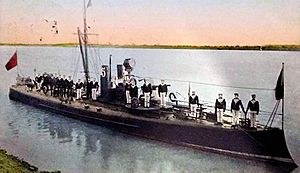Căpitan Romano Mihail-class armored motor launch facts for kids
 |
|
Quick facts for kids Class overview |
|
|---|---|
| Name: | Căpitan Romano Mihail-class armored motor launch |
| Builders: | Thames Iron Works, London |
| Operators: |
|
| Built: | 1906–1907 |
| In service: | 1907–1945? |
| Completed: | 3 (8 initially) |
| Retired: | 3 |
| General characteristics | |
| Displacement |
|
| Length | 30 meters |
| Beam | 4 meters |
| Draft | 0.8 meters |
| Propulsion | 2 compound engines, 2 shafts, 550 hp |
| Speed | 18 knots |
| Range | 7.6 tons of fuel |
| Complement | 20 |
| Armament |
|
| Notes | Bulletproof sides and deck (~20 mm) |
The Căpitan Romano Mihail-class was a group of three special armored boats. These boats were used by the Romanian Navy during both World War I and World War II. They were designed to be tough and well-armed.
Contents
Building These Boats
These boats were built in the United Kingdom between 1906 and 1907. They were made at a place called Thames Iron Works in London.
Originally, there were supposed to be eight of these boats. But only three of them ended up serving for a long time.
What They Looked Like
Each boat was about 30 meters long, which is like three school buses lined up. They were 4 meters wide and sat about 0.8 meters deep in the water.
When empty, they weighed 45 tons. When fully loaded, they weighed 51 tons.
How They Moved
These boats had two engines that gave them 550 hp. This power allowed them to travel quite fast, reaching a top speed of 18 knots. That's about 33 kilometers per hour!
They could carry up to 7.6 tons of fuel. This let them travel for a good distance.
Their Protection and Weapons
The sides and deck of these boats were covered in special armor. This armor was strong enough to stop bullets. It was likely around 20 millimeters thick.
Each boat had a crew of 20 people.
When they were first built, their weapons included:
- One 47 mm Skoda naval gun.
- One 6.5 mm Maxim machine gun.
- Four torpedoes. Torpedoes are like underwater missiles. Some were on long poles (spar torpedoes), and others could be dropped into the water.
Their Service History
These boats were first called "river torpedo boats." They were used in this role during World War I. Sadly, one boat was sunk by an underwater mine in 1916.
Only three of the original boats survived until the end of World War II. These three boats were named Căpitan Romano Mihail, Locotenent Călinescu Dimitrie, and Maior Șonțu Ghoerghe. They were originally boats number 1, 3, and 4 from the first group.
Changes Over Time
During World War II, the boats were updated. Their old 6.5 mm machine guns were replaced with stronger 20 mm autocannons. These were better for shooting down enemy aircraft.
They also added a special weapon called a 300 mm depth charge thrower. Depth charges are bombs that explode underwater. They are used to attack submarines.
These boats were very good at handling rough seas. Because of this, in August 1944, they were included in the Soviet Black Sea Fleet. This was instead of a river fleet, showing how tough they were.
They were returned to Romania in September 1945.

